What is South Africa’s New Law on Climate Change?
South Africa’s President, Cyril Ramaphosa, has signed a new Climate Change Bill into law. This law requires big fossil-fuel industries to reduce their emissions and makes local governments create plans to adapt to climate change. This action shows South Africa’s dedication to the Paris Agreement, which aims to cut down greenhouse gas (GHG) emissions.
South Africa’s Emissions Landscape
South Africa relies heavily on coal for its electricity, placing it among the top 15 countries in the world for GHG emissions. In 2022, the country emitted 405 million tonnes of CO2, which is a bit less than in previous years. The energy sector is responsible for about 80% of these emissions.
Nationally Determined Contributions (NDC)
Each country has to submit Nationally Determined Contributions (NDCs), which are plans for how they will reduce emissions. South Africa submitted its first NDC in 2016 and updated it in 2021. The updated plan aims to reduce emissions by 31% and set targets of 398-510 million tonnes of CO2 by 2025 and 350-420 million tonnes by 2030.
Goals for Transition
The updated NDC focuses on a ‘just transition,’ which means creating sustainable jobs in agriculture, forestry, energy, and waste management. South Africa estimates it will need $8 billion each year until 2030 to reach its climate goals, and it aims to have net-zero emissions by 2050.
Policy Framework Development
In 2022, the Presidential Climate Commission released a Just Transition Framework to link climate policies with development needs, supporting significant changes in South Africa’s economy.
Contrasting with India
In contrast, India does not have a comprehensive national climate law. Instead, it uses existing environmental laws to address climate issues. Efforts to create a dedicated Council on Climate Change have stalled. However, the Indian Supreme Court has recognized citizens’ rights against climate change impacts and urged the government to connect these rights with climate policies.
India reported a 33% reduction in emissions intensity from 2005 to 2019, achieving this ahead of schedule. It aims to cut emissions intensity by 45% by 2030 and plans to generate 50% of its electricity from non-fossil fuel sources by the same year.
Month: Current Affairs - July, 2024
Category: Legal & Constitution Current Affairs








